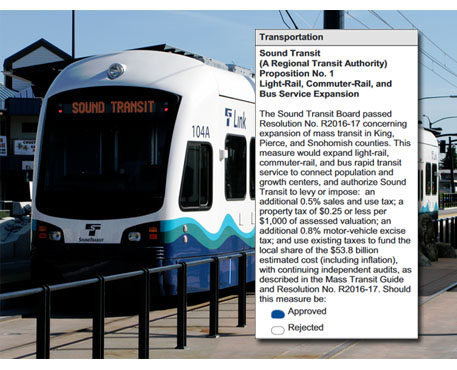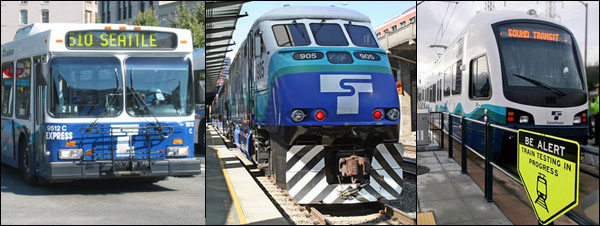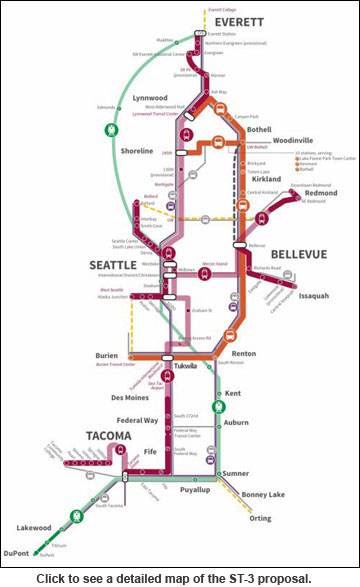ELECTION
ST Prop. 1: Good jobs now and in the future
(Nov. 7, 2016) — Tomorrow is Election Day and for voters who want to promote good jobs and improve the state economy in Washington, Initiative 1433 to raise the minimum wage and allow all to earn paid sick leave isn’t the only ballot measure that deserves their support. Voters in King, Snohomish and Pierce counties can also support Sound Transit Proposition 1, which will connect people to work, homes, schools and services, improve freight mobility and boost the economy for us — and for our children and grandchildren.
 Prop. 1 (also known as Sound Transit Phase 3 or ST3) adds 62 new miles of light rail with stations serving 37 additional areas for a regional system reaching 116 miles. The plan also establishes Bus Rapid Transit on I-405/SR 518 and SR 522/NE 145th; expands capacity and service of the Sounder south rail line; includes ST Express bus service; improves access to stations for bicyclists, pedestrians, drivers, and pick-up and drop-off services, and expands parking at stations.
Prop. 1 (also known as Sound Transit Phase 3 or ST3) adds 62 new miles of light rail with stations serving 37 additional areas for a regional system reaching 116 miles. The plan also establishes Bus Rapid Transit on I-405/SR 518 and SR 522/NE 145th; expands capacity and service of the Sounder south rail line; includes ST Express bus service; improves access to stations for bicyclists, pedestrians, drivers, and pick-up and drop-off services, and expands parking at stations.
Prop. 1 will also create good construction jobs for decades. Nearly 13 million construction labor hours have been completed since the founding of Sound Transit; 17 million labor hours are funded and remain to be worked from Mass Transit Now’s successful 2008 campaign. Prop. 1 will add about 44 million construction hours through 2041. Plus, Sound Transit has a standalone Project Labor Agreement (PLA) for the construction of Sounder Commuter Rail and Link Light Rail projects. This PLA, in place since 1999, guarantees that all work will pay prevailing wages and union-scale benefits.
“Voting for Sound Transit Proposition 1 (ST3) is an investment in our future,” writes Jeff Johnson, President of the Washington State Labor Council, AFL-CIO. “It is an investment in jobs. It is an investment in congestion relief and a higher quality of life. It is an investment in lowering carbon pollution and a cleaner environment. It is an investment that will benefit our children and grandchildren for decades to come.”
Here are some specific highlights of the Prop. 1 plan:
● With 62 new miles of light rail, ST3 completes a 116-mile regional system, five times larger than it is today, reaching Everett, Tacoma, Seattle neighborhoods of Ballard and West Seattle, and new Eastside destinations of Redmond, south Kirkland, Bellevue, and central Issaquah.
● Builds on extensions now being planned and constructed to Angle Lake, Northgate, Lynnwood, Mercer Island, Bellevue, Overlake.
● Extends Tacoma Link west to Tacoma Community College with six stations.
● Provides service 20 hours each day, every 6 minutes in peak and every 10 minutes in non-peak hours.
● Light rail is fast, travelling in its own right-of-way separated from traffic to reach destinations at the same time every day, regardless of weather or traffic congestion.
● Under ST3, light rail is projected to serve about 600,000 riders every day.
Bus Rapid Transit (BRT)
● BRT provides fast, reliable bus service every 10 minutes in peak hours along I-405, SR 518, SR 522 and NE 145th Street, connecting to light rail service in Bellevue, Tukwila, Shoreline and Lynnwood.
● BRT operates in the Express Toll lanes between Totem Lake and south Renton and mainly on exclusive right-of-way between Tukwila and Burien Transit Center, allowing users to take advantage of higher speeds.
● Builds inline freeway stations that allow buses to stop within the freeway right-of-way to pick up/unload riders at NE 85th Street in Kirkland and NE 44th Street in Renton, and a new transit center and parking garage in south Renton.
● Provides new or expanded parking at Totem Lake, NE 44th in Renton, South Renton, North Sammamish, Lake Forest Park, Kenmore and Bothell.

Sounder Train Service (40% more passengers)
● ST3 responds to fast-growing south line ridership (15 percent growth in the last year) by increasing capacity with extended platforms that could serve trains up to 10 cars in length and approximately 40% more passengers at Lakewood, Tacoma, Puyallup, Sumner, Auburn, Kent and Tukwila.
● In addition to expanding train capacity, ST3 provides the potential to run more trains during the day.
● Two stations added to the south line, one at Tillicum to serve Joint Base Lewis-McChord and a second at DuPont.
● New parking built at the north line stations at Edmonds and Mukilteo, and access improvements are made to both the north and south lines.
ST Express Bus and other extended services
● ST Express continues serving key long distance corridors.
● Capital contributions improve bus speed and reliability along Pacific Avenue in Tacoma, between cities in East Pierce County and the Sumner Sounder station, and frequent bus service between Lakewood and Tacoma.
● The Bus-on-Shoulder program provides opportunities for buses to use shoulders on freeways and state highways to bypass congestion where feasible.
● A capped contribution to Madison Street BRT along with improvements to RapidRide C and D lines speeds service to Ballard and West Seattle while light rail to those communities is under construction.
 Responding to Population Growth
Responding to Population Growth
● The ST3 Plan responds to the region’s rising population. Congestion on the region’s highways increased 95% from 2010 to 2015. (WSDOT) As a result, the average peak hour commuter in the Seattle area spent 63 hours stuck in traffic in 2014. (Texas A&M Transportation Institute Urban Mobility Report).
● Last year the region grew by 52,000 people, that’s 1,000 new residents every week. Population is projected to continue growing by 800,000 by 2040.
● ST3 enables more people to access fast and reliable transit that can meet demand many decades into the future.
Environmental Considerations
● Regionally, transportation is the largest source of the air pollution that causes global warming.
● With ST3, annual vehicle miles driven in the region by 2040 are projected to reduce by 314-411 million miles as people shift from driving to transit.
● As a result of previously approved and ST3 projects, an estimated 793,000 metric tons of greenhouse gas emissions will be saved annually by 2040. That’s the equivalent of burning more than 4,224 railcars of coal.
● ST3 is consistent with regional land use and transportation plans, encouraging development of vibrant, walkable communities, that can help contain sprawl.
Economic Considerations
● ST3 is projected to create more than 78,000 direct jobs and more than 144,000 indirect jobs over the 25-year period of construction, for a total of over 223,000 jobs. A job is defined as full-time employment of one person for one year.
● Businesses consider transportation system performance as a factor influencing decisions about where to locate and expand.
● With ST3 approximately 84% of Sound Transit District residents and 93% of district workers have convenient access to the region’s high-reliability rail and BRT system by 2040.
Learn more at the Sound Transit 3 overview webpage.
ALSO at The Stand:
Approve Sound Transit Proposition 1 (ST3) to invest in jobs, our future (by WSLC President Jeff Johnson)
We needn’t choose. We can have great transit AND fund schools. (by Rep. Joe Fitzgibbon)






